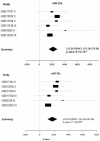Computational analysis of mRNA expression profiles identifies microRNA-29a/c as predictor of colorectal cancer early recurrence
- PMID: 22348113
- PMCID: PMC3278467
- DOI: 10.1371/journal.pone.0031587
Computational analysis of mRNA expression profiles identifies microRNA-29a/c as predictor of colorectal cancer early recurrence
Abstract
Colorectal cancer (CRC) is one of the leading malignant cancers with a rapid increase in incidence and mortality. The recurrences of CRC after curative resection are sometimes unavoidable and often take place within the first year after surgery. MicroRNAs may serve as biomarkers to predict early recurrence of CRC, but identifying them from over 1,400 known human microRNAs is challenging and costly. An alternative approach is to analyze existing expression data of messenger RNAs (mRNAs) because generally speaking the expression levels of microRNAs and their target mRNAs are inversely correlated. In this study, we extracted six mRNA expression data of CRC in four studies (GSE12032, GSE17538, GSE4526 and GSE17181) from the gene expression omnibus (GEO). We inferred microRNA expression profiles and performed computational analysis to identify microRNAs associated with CRC recurrence using the IMRE method based on the MicroCosm database that includes 568,071 microRNA-target connections between 711 microRNAs and 20,884 gene targets. Two microRNAs, miR-29a and miR-29c, were disclosed and further meta-analysis of the six mRNA expression datasets showed that these two microRNAs were highly significant based on the Fisher p-value combination (p = 9.14 × 10(-9) for miR-29a and p = 1.14 × 10(-6) for miR-29c). Furthermore, these two microRNAs were experimentally tested in 78 human CRC samples to validate their effect on early recurrence. Our empirical results showed that the two microRNAs were significantly down-regulated (p = 0.007 for miR-29a and p = 0.007 for miR-29c) in the early-recurrence patients. This study shows the feasibility of using mRNA profiles to indicate microRNAs. We also shows miR-29a/c could be potential biomarkers for CRC early recurrence.
Conflict of interest statement
Figures


Similar articles
-
Identifying microRNA-mRNA regulatory network in colorectal cancer by a combination of expression profile and bioinformatics analysis.BMC Syst Biol. 2012 Jun 15;6:68. doi: 10.1186/1752-0509-6-68. BMC Syst Biol. 2012. PMID: 22703586 Free PMC article.
-
Functional role of a long non-coding RNA LIFR-AS1/miR-29a/TNFAIP3 axis in colorectal cancer resistance to pohotodynamic therapy.Biochim Biophys Acta Mol Basis Dis. 2018 Sep;1864(9 Pt B):2871-2880. doi: 10.1016/j.bbadis.2018.05.020. Epub 2018 May 25. Biochim Biophys Acta Mol Basis Dis. 2018. PMID: 29807108
-
Diagnostic performance of microRNA-29a for colorectal cancer: a meta-analysis.Genet Mol Res. 2015 Dec 22;14(4):18018-25. doi: 10.4238/2015.December.22.28. Genet Mol Res. 2015. PMID: 26782449
-
MicroRNA-29a promotes colorectal cancer metastasis by regulating matrix metalloproteinase 2 and E-cadherin via KLF4.Br J Cancer. 2014 Jan 21;110(2):450-8. doi: 10.1038/bjc.2013.724. Epub 2013 Nov 26. Br J Cancer. 2014. PMID: 24281002 Free PMC article.
-
MiR-29a-3p: a potential biomarker and therapeutic target in colorectal cancer.Clin Transl Oncol. 2023 Mar;25(3):563-577. doi: 10.1007/s12094-022-02978-6. Epub 2022 Nov 10. Clin Transl Oncol. 2023. PMID: 36355327 Free PMC article. Review.
Cited by
-
Effect of miR‑29a‑3p in exosomes on glioma cells by regulating the PI3K/AKT/HIF‑1α pathway.Mol Med Rep. 2023 Mar;27(3):72. doi: 10.3892/mmr.2023.12959. Epub 2023 Feb 17. Mol Med Rep. 2023. PMID: 36799154 Free PMC article.
-
lncRNA GAS5 Inhibits Cell Migration and Invasion and Promotes Autophagy by Targeting miR-222-3p via the GAS5/PTEN-Signaling Pathway in CRC.Mol Ther Nucleic Acids. 2019 Sep 6;17:644-656. doi: 10.1016/j.omtn.2019.06.009. Epub 2019 Jun 27. Mol Ther Nucleic Acids. 2019. Retraction in: Mol Ther Nucleic Acids. 2022 Nov 19;30:510. doi: 10.1016/j.omtn.2022.11.014. PMID: 31400607 Free PMC article. Retracted.
-
The Role of miRNA in the Pathophysiology of Neuroendocrine Tumors.Int J Mol Sci. 2021 Aug 9;22(16):8569. doi: 10.3390/ijms22168569. Int J Mol Sci. 2021. PMID: 34445276 Free PMC article. Review.
-
MiR-29a: a potential therapeutic target and promising biomarker in tumors.Biosci Rep. 2018 Feb 8;38(1):BSR20171265. doi: 10.1042/BSR20171265. Print 2018 Feb 28. Biosci Rep. 2018. PMID: 29217524 Free PMC article. Review.
-
Loss of APAF-1 expression is associated with early recurrence in stage I, II, and III colorectal cancer.Langenbecks Arch Surg. 2016 Dec;401(8):1203-1210. doi: 10.1007/s00423-016-1483-3. Epub 2016 Aug 2. Langenbecks Arch Surg. 2016. PMID: 27480415
References
-
- Jemal A, Siegel R, Ward E, Hao Y, Xu J, et al. Cancer statistics, 2009. CA Cancer J Clin. 2009;59:225–249. - PubMed
-
- Weitz J, Koch M, Debus J, Hohler T, Galle PR, et al. Colorectal cancer. Lancet. 2005;365:153–165. - PubMed
-
- Yang L, Parkin DM, Li L, Chen Y. Time trends in cancer mortality in China: 1987–1999. Int J Cancer. 2003;106:771–783. - PubMed
-
- Wolpin BM, Meyerhardt JA, Mamon HJ, Mayer RJ. Adjuvant treatment of colorectal cancer. CA Cancer J Clin. 2007;57:168–185. - PubMed
-
- Longo WE, Johnson FE. The preoperative assessment and postoperative surveillance of patients with colon and rectal cancer. Surg Clin North Am. 2002;82:1091–1108. - PubMed
Publication types
MeSH terms
Substances
LinkOut - more resources
Full Text Sources
Medical

